Epidemiological Surveillance of Hypodermosis in Cattle from Romania
Abstract
1. Introduction
2. Materials and Methods
3. Results
3.1. Descriptive Epidemiology
3.2. Molecular Epidemiology
4. Discussion
5. Conclusions
Author Contributions
Funding
Institutional Review Board Statement
Informed Consent Statement
Conflicts of Interest
References
- Sanchez, J.; Dohoo, I.; Nødtvedt, A.; Keefe, G.; Markham, F.; Leslie, K.; Descôteaux, L.; Campbell, J. A longitudinal study of gastrointestinal parasites in Canadian dairy farms. The value of an indirect Ostertagia ostertagi ELISA as a monitoring tool. Vet. Parasitol. 2002, 107, 209–226. [Google Scholar] [CrossRef] [PubMed]
- Khan, M.N.; Iqbal, Z.; Sajid, M.S.; Anwar, M.; Needham, G.R.; Hassan, M. Bovine hypodermosis: Prevalence and economic significance in southern Punjab, Pakistan. Vet. Parasitol. 2006, 141, 386–390. [Google Scholar] [CrossRef]
- Otranto, D.; Johnson, G.; Syrvud, K.; Yoon, S.; Hunter, J.S.; Rehbein, S. Treatment and control of bovine hypodermosis with ivermectin long-acting injection (IVOMEC GOLD). Parasit. Vectors 2016, 9, 551. [Google Scholar] [CrossRef] [PubMed][Green Version]
- Reina, D.; Hurtado, F.J.; Martinez-Moreno, F.J.; Hernandez-Rodriguez, S.; Navarrete, I. Method for collecting Hypoderma spp. (Diptera: Oestridae) larvae from cattle. J. Med. Entomol. 1998, 35, 327–329. [Google Scholar] [CrossRef] [PubMed]
- Hiepe, T.; Ribbeck, R.; Mieth, K.; Garz, I. Results of the systematic state-directed control of hypodermosis in the German Democratic Republic. Angew. Parasitol. 1974, 15, 57–67. [Google Scholar] [PubMed]
- Cosoroaba, I. Parazitologie Veterinara; Mirton: Timisoara, Romania, 2000. [Google Scholar]
- Darabus, G.; Oprescu, I.; Morariu, S.; Mederle, N.; Ilie, M.; Imre, M. Parazitologie si Boli Parazitare; Mirton: Timisoara, Romania, 2022. [Google Scholar]
- Colwell, D.D.; Martinez-Moreno, F.J.; Martinez-Moreno, A.; Hernandez-Rodriguez, S.; de la Fuente-Lopez, C.; Alunda, J.M.; Hall, M.J. Comparative scanning electron microscopy of third-instar Hypoderma spp. (Dipetra: Oestridae). Med. Vet. Entomol. 1998, 12, 181–186. [Google Scholar] [CrossRef]
- Otranto, D.; Traversa, D.; Guida, B.; Tarsitano, E.; Fiorente, P.; Stevens, J.R. Molecular characterization of the mitochondrial cytochrome oxidase I gene of oestridae larvae causing obligate myiasis. Med. Vet. Entomol. 2003, 17, 307–315. [Google Scholar] [CrossRef] [PubMed]
- Wiszniewska-Łaszczych, A.; Wysok, B.; Wojtacka, J.; Sołtysiuk, M. Effect of Mixed Invasions of Hypoderma bovis and Ostertagia ostertagi in Cattle on Milk Yield and Contents in Polish Dairy Farms. Animals 2021, 11, 464. [Google Scholar] [CrossRef]
- Rehbein, S.; Holste, J.E.; Smith, L.L.; Lloyd, J.L. The efficacy of eprinomectin extended-release injection against Hypoderma spp. (Diptera: Oestridae) in cattle. Vet. Parasitol. 2013, 192, 353–358. [Google Scholar] [CrossRef][Green Version]
- Boulard, C. Durably controlling bovine hypodermosis. Vet. Res. 2002, 33, 455–464. [Google Scholar] [CrossRef]
- Rappelli, P.; Varcasia, A.; Vargiu, A.; Scala, A. Case report: First report of autochthonous Human Cutaneous Myasis caused by Hypoderma lineatum in Europe. Am. J. Trop Med. Hyg. 2018, 99, 618–619. [Google Scholar] [CrossRef] [PubMed]
- Puente, S.M.D.; Otranto, D.; Panadero, R.; Herrero, M.D.; Rivas, P.; Ramirez-Olivencia, G.; Mariscal, C.; Maria, J.R.; Perteguer, J.; Diez Banos, P.; et al. First diagnosis of an imported Human Myasis caused by Hypoderma sinense (Diptera: Oestridae), detected in a European Traveler returning from India. J. Trav. Med. 2010, 6, 419–423. [Google Scholar] [CrossRef] [PubMed]
- Hassan, M.U.; Khan, M.N.; Abubakar, M.; Waheed, H.M.; Iqbal, Z.; Hussain, M. Bovine hypodermosis—A global aspect. Trop. Anim. Health Prod. 2010, 42, 1615–1625. [Google Scholar] [CrossRef] [PubMed]
- Cozma, V.; Suteu, E. Epidemiology and Aetiology of Bovine Hypodermosis in Northwestern Romania. In Improvements in the Control Methods for Warble-Fly in Cattle and Goats; Tarry, D.W., Pithan, K., Webster, K., Eds.; Commission of the European Communities: Brussels, Belgium, 1995; pp. 65–68. [Google Scholar]
- Oprescu, I.; Dărăbuş, G.; Tântă, M. Evoluția hipodermozei bovine în județul Maramureş în perioada 2000–2003. Sci. Parasitol. 2005, 1–2, 132–135. [Google Scholar]
- Gorcea, F.C.; Calescu, N.; Gherman, C.M.; Mihalca, A.D.; Cozma, V. Diagnostic values of clinical, pathological and serologic findings in cattle hypodermosis in Pestisani, Gorj County, Romania. Sci. Parasitol. 2011, 12, 173–176. [Google Scholar]
- Puccini, V.; Giangaspero, A.; Fasanella, A. Incidence of bovine hypodermosis in Apulia region (Italy). In Improvements in the Control Methods for Warble-Fly in Cattle and Goats; Hernandez, S., Gasca, A., Martinez, J., Pithan, K., Eds.; Commission of the European Communities: Brussels, Belgium, 1991; pp. 9–20. [Google Scholar]
- Frangipane di Regalbono, A.; Capelli, G.; Otranto, D.; Pietrobelli, M. Assessment of cattle grub (Hypoderma spp.) prevalence in northeastern Italy: An immunoepidemiological survey on bulk milk samples using ELISA. Vet. Parasitol. 2003, 111, 343–350. [Google Scholar] [CrossRef]
- Abdul-Hak, J. Seasonal occurrence of Hypoderma spp. (Diptera: Oestridae) warble flies on cattle in Baghdad area. Iraq Bull. Endemic. Dis. 1973, 14, 73–81. [Google Scholar]
- Papadopoulos, E. Hypodermosis in Greece. Chin. J. Vet. Parasitol. 2004, 12, 20–23. [Google Scholar]
- Yin, H.; Miling, H.; Gailing, H.; Haung, S.; Zheijie, L.; Jiaxutn, L.; Guiquan, G. Hypodermosis in China. In Proceedings of the INCO Conference, Athens, Greece, 9–10 June 2010. [Google Scholar]
- Otranto, D.; Zalla, P.; Testini, G.; Zanaj, S. Cattle grub infestation by Hypoderm asp. in Albania and risks for European countries. Vet. Parasitol. 2005, 128, 157–162. [Google Scholar] [CrossRef]
- Cencek, T.; Ziomko, I. Development of the ELISA kit for the detection of Hypoderma bovis antibodies in cattle. II. Setting the best terms for collecting blood samples for the lavoratory diagnostic of hypodermyiasis in different regions of Poland. Wiad Parazytol. 2001, 47, 505–510. [Google Scholar]
- Beesley, W.N. Economics and progress of warble fly eradication in Britain. Vet. Med. Rev. 1974, 4, 334–347. [Google Scholar]
- Benakhla, A.; Lonneux, J.F.; Mekroud, A.; Losson, B.; Boulard, C. Hypodermose bovine dans le Nord-Est algérien: Prévalence et intensité d’infestation [Bovine hypodermosis in north-eastern Algeria: Prevalence and intensity of infestation]. Vet. Res. 1999, 30, 539–545. [Google Scholar]
- Fu, Y.; Li, W.; Duo, H.; Guo, Z.H.; Li, Y.; Zhang, Y.M. Genetic diversity and population genetics of the warble flies Hypoderma bovis and H. sinense in Qinghai Province, China. Parasit. Vectors 2016, 9, 145. [Google Scholar] [CrossRef]
- Otranto, D.; Traversa, D.; Colwell, D.D.; Guan, G.; Giangaspero, A.; Boulard, C.; Yin, H. A third species of Hypoderma (Diptera: Oestridae) affecting cattle and yaks in China: Molecular and morphological evidence. J. Parasitol. 2004, 90, 958–965. [Google Scholar] [CrossRef]
- Ilie, M.S.; Imre, M.I.; Hotea, I.O.; Imre, K.; Sorescu, I.D.; Andrei, S.; Onita, P.; Oprescu, I.; Morariu, S.; Mihali, C.; et al. Prevalence of Hypoderma infestation in deer in western Romania. Lucr. St. Med. Vet. 2012, XIV, 121–125. [Google Scholar]
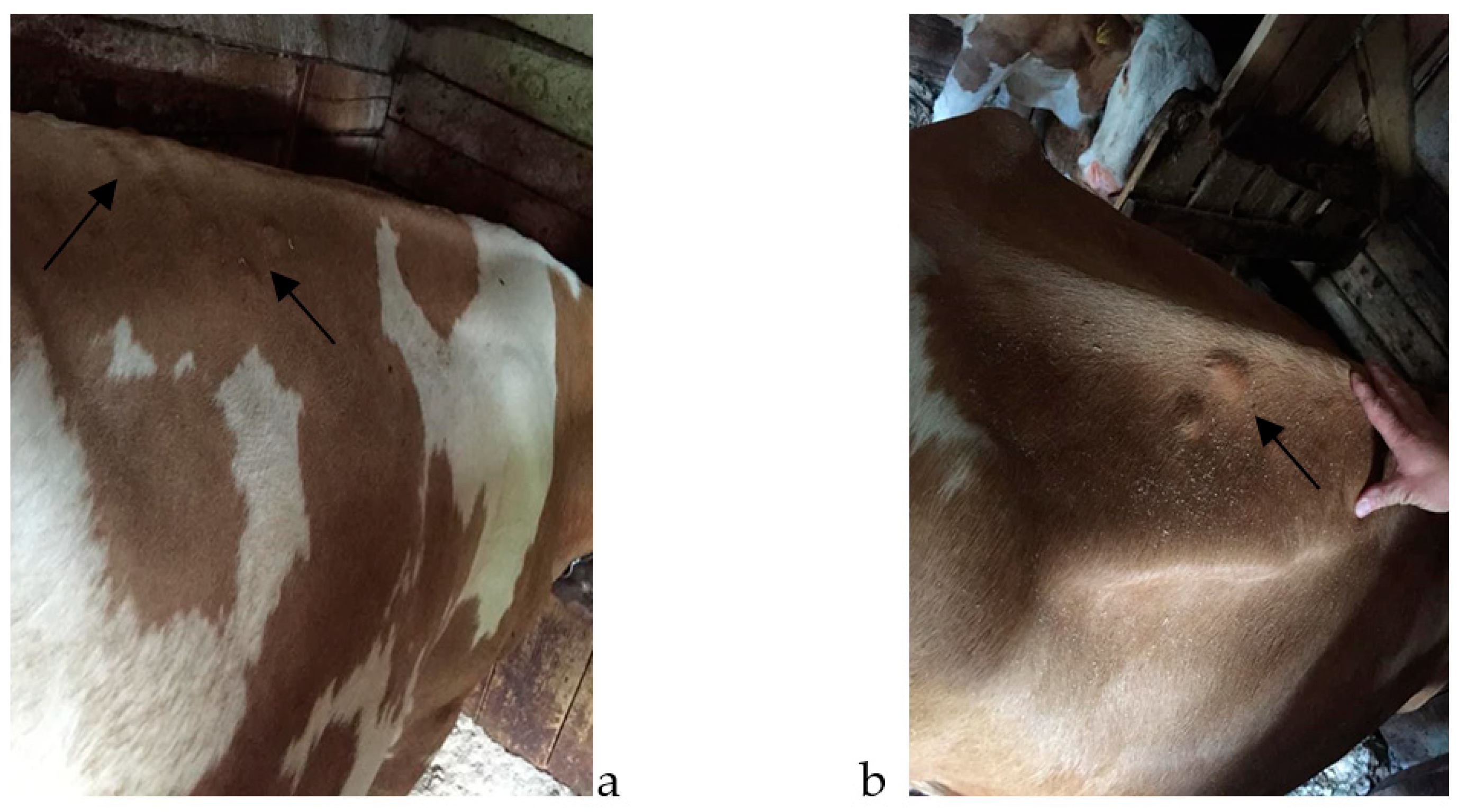
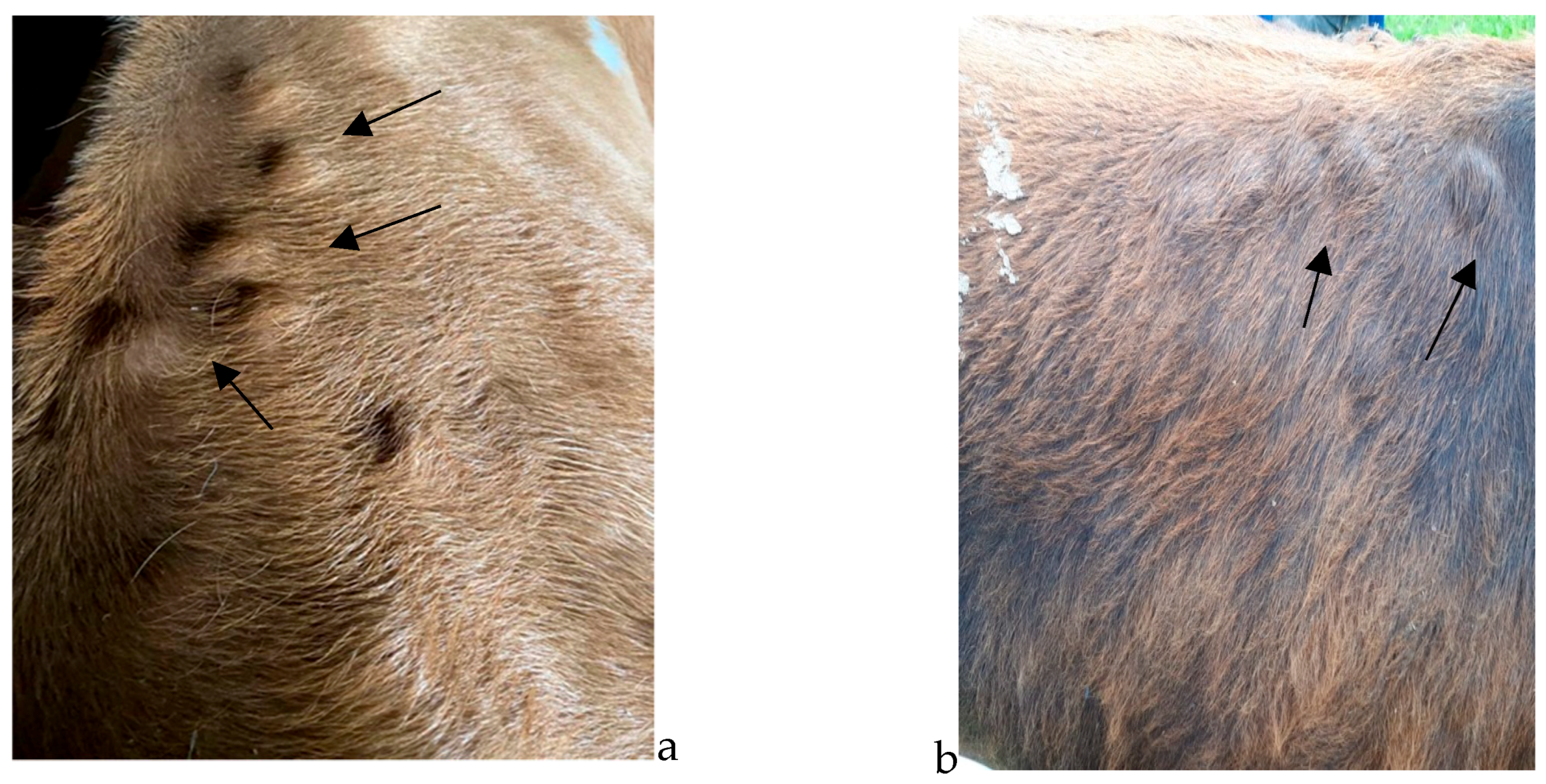
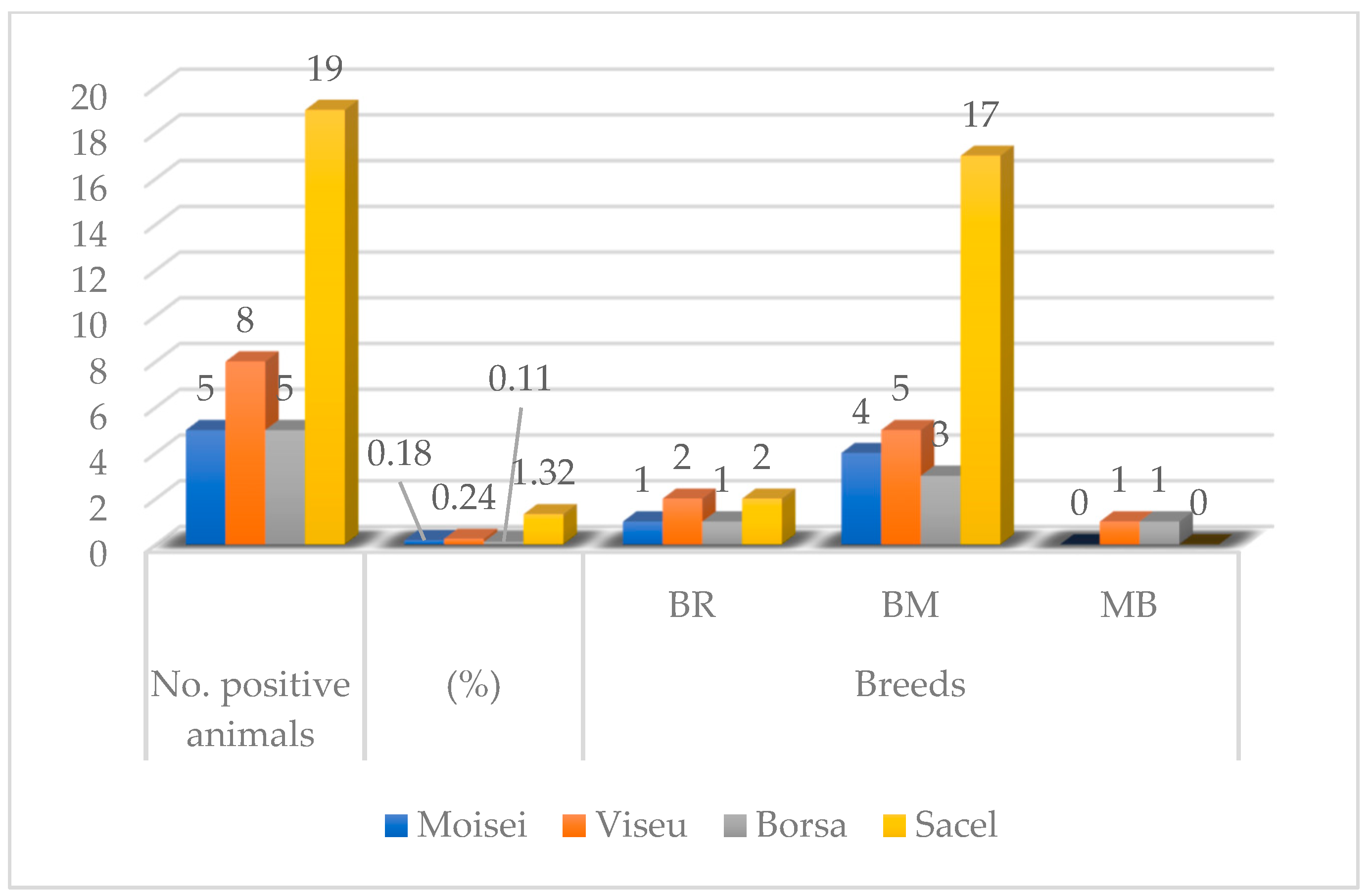
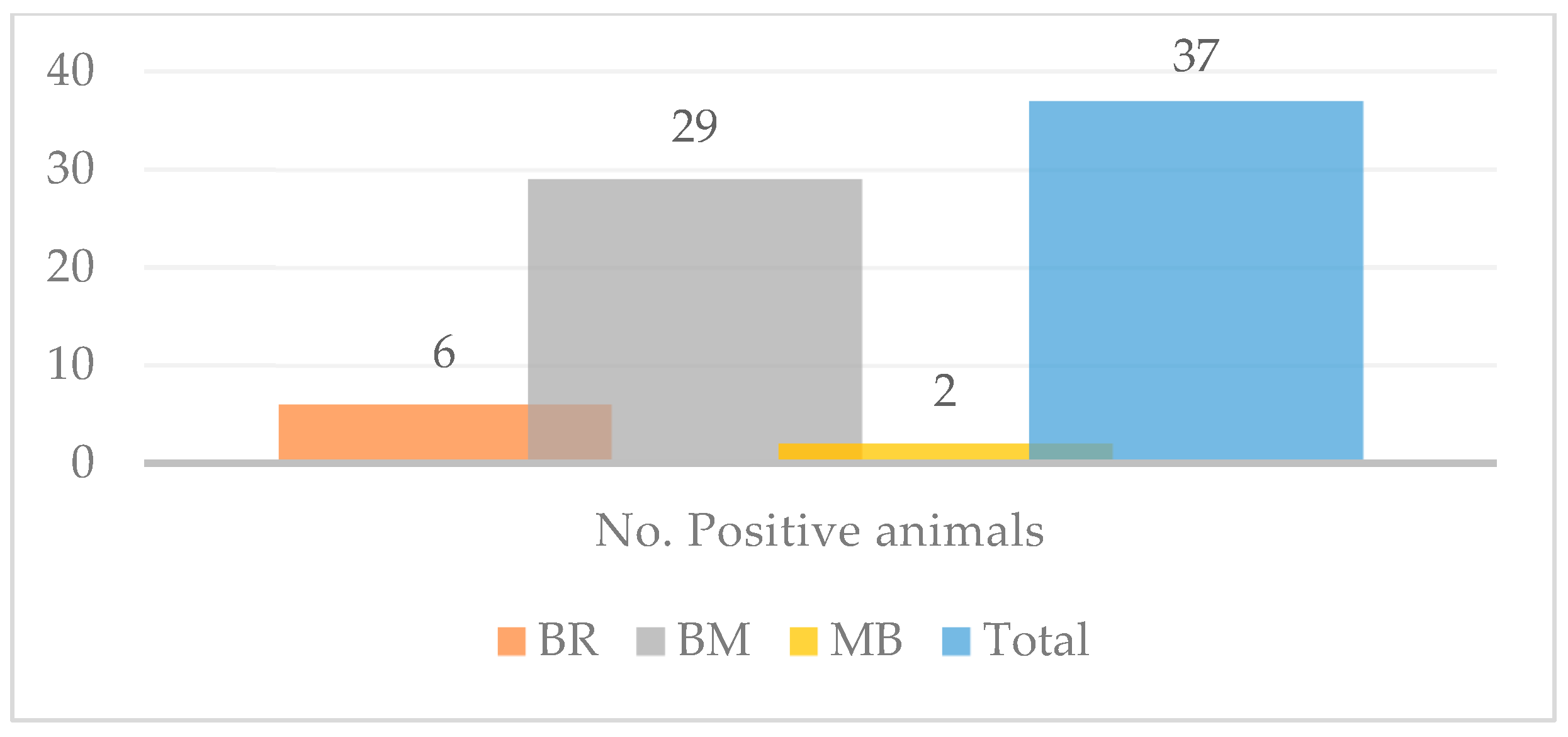
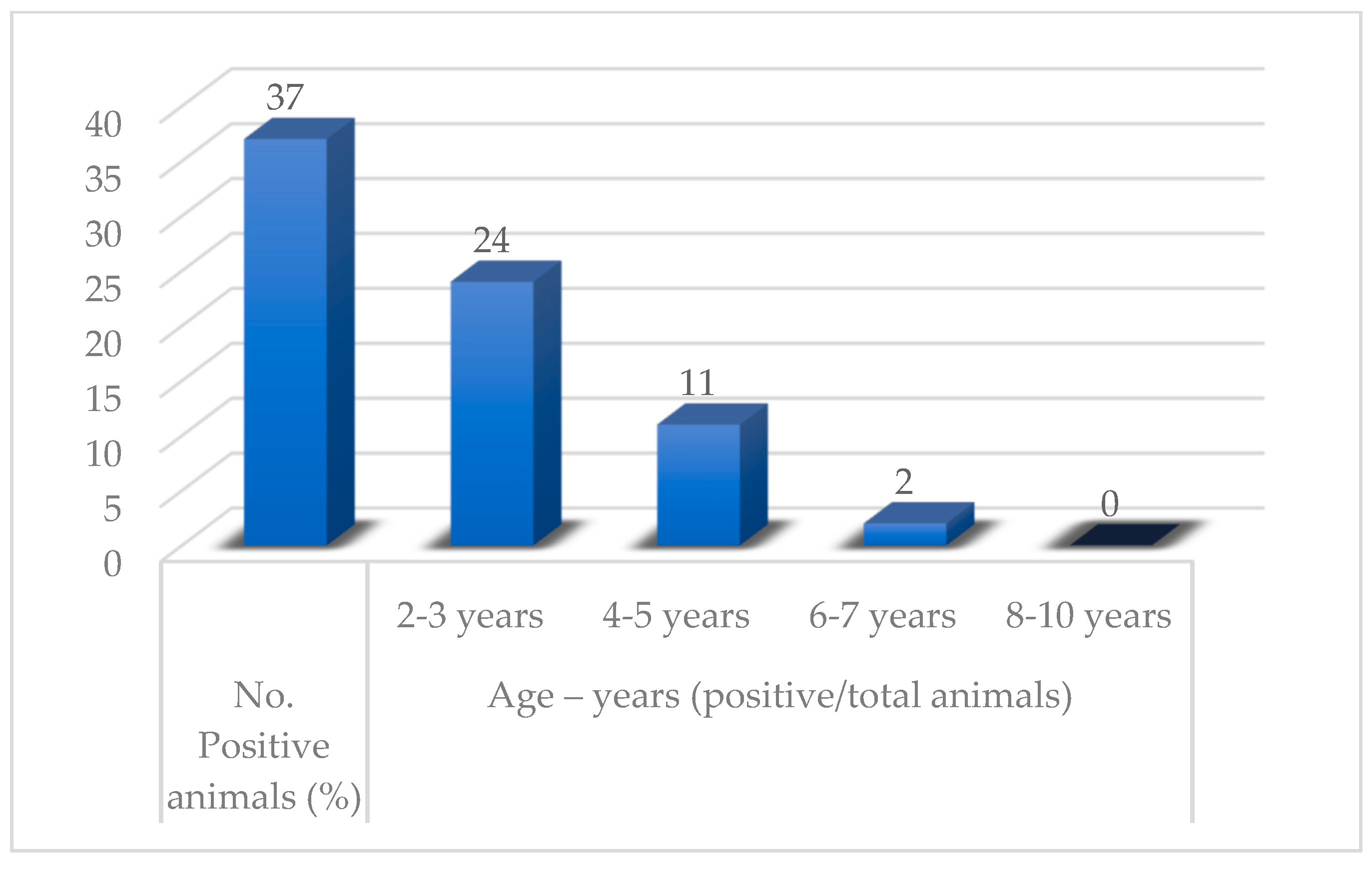
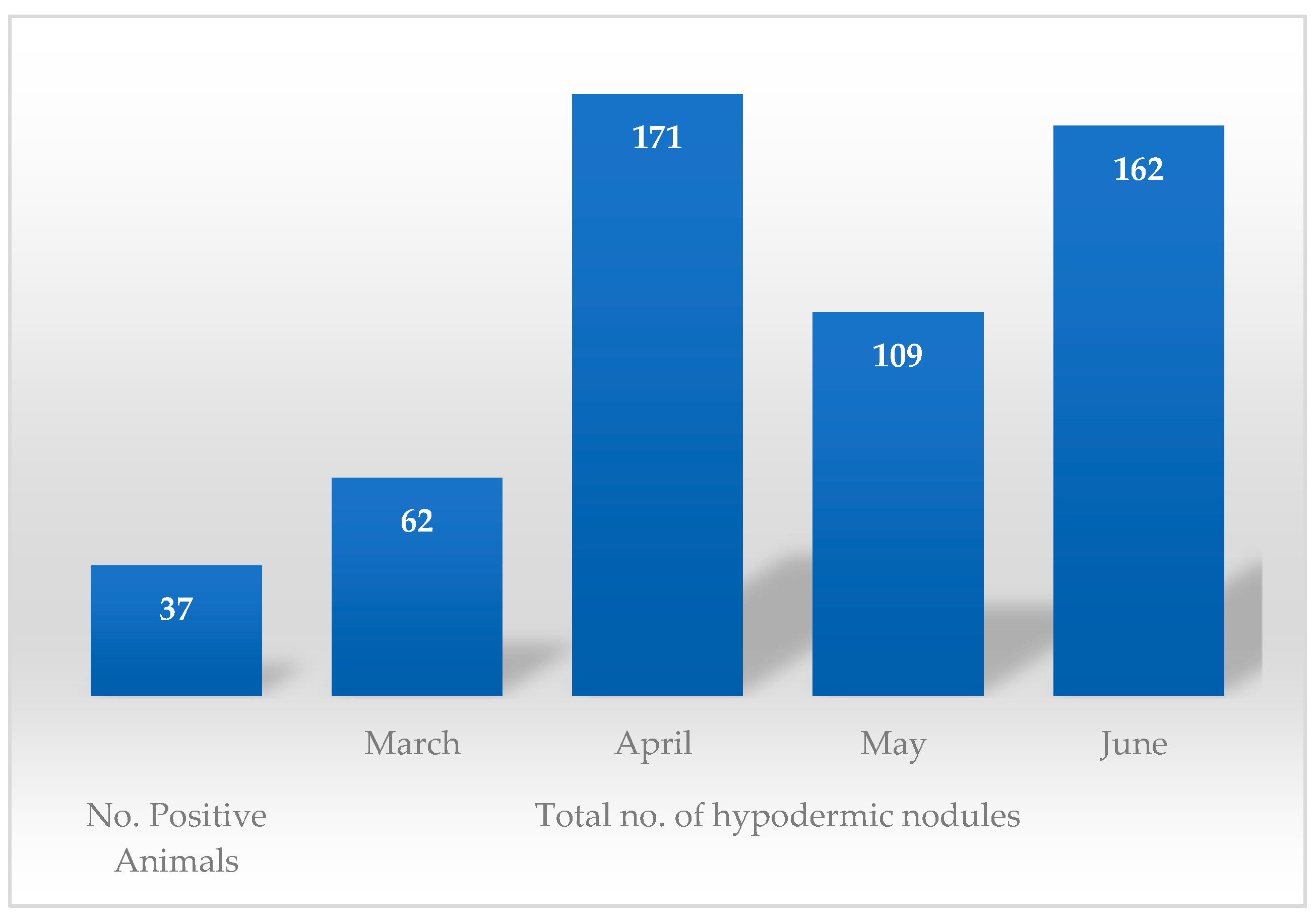
| Location | No. of Examined Animals | No. of Positive Animals (%) | Breeds | ||
|---|---|---|---|---|---|
| BR | BM | MB | |||
| Moisei | 2667 | 5 (0.18) | 1 | 4 | 0 |
| Vișeu | 3215 | 8 (0.24) | 2 | 5 | 1 |
| Borșa | 4420 | 5 (0.11) | 1 | 3 | 1 |
| Săcel | 1439 | 19(1.32) | 2 | 17 | 0 |
| TOTAL | 11,741 | 37 (0.31) | 6 | 29 | 2 |
| Breed | No. of Examined Animals | No. of Positive Animals (%) | Age Group (Positive/Total No. of Animals) | |||
|---|---|---|---|---|---|---|
| 2–3 Years | 4–5 Years | 6–7 Years | 8–10 Years | |||
| BR | 2843 | 6 (0.21) | 5/379 | 0/793 | 1/632 | 0/1039 |
| BM | 6320 | 29 (0.45) | 18/847 | 10/1760 | 1/1108 | 0/2605 |
| MB | 2578 | 2 (0.07) | 1/322 | 1/637 | 0/701 | 0/918 |
| TOTAL | 11,741 | 37 (0.31) | 24/1548 | 11/3190 | 2/2441 | 0/4562 |
| Location | No. of Positive Animals | Total No. of Hypodermic Nodules | |||
|---|---|---|---|---|---|
| March (Max–Min) | April (Max–Min) | May (Max–Min) | June (Max–Min) | ||
| Moisei | 5 | 17 (2–5) | 30 (4–8) | 19 (1–6) | 11 (1–4) |
| Vișeu | 8 | 21 (1–5) | 70 (4–15) | 47 (2–12) | 25 (2–7) |
| Borșa | 5 | 15 (2–4) | 48 (6–14) | 25 (3–7) | 20 (1–5) |
| Săcel | 19 | 9 (2–4) | 23 (5–10) | 18 (4–10) | 106 (1–11) |
| Total | 37 | 62 (1–5) | 171 (4–15) | 109 (1–12) | 162 (1–11) |
| AGE | |||
| 2–3 | vs. | 4–5 | 0.0001 |
| 2–3 | 6–7 | 0.0001 | |
| 2–3 | 8–10 | 0.0001 | |
| 4–5 | 6–7 | 0.0500 | |
| 4–5 | 8–10 | 0.0001 | |
| 6–7 | 8–10 | 0.1216 | |
| BREED | |||
| BR | BM | 0.0979 | |
| BR | HB | 0.2935 | |
| BM | HB | 0.0044 | |
| March (Max–Min) | April (Max–Min) | p value equals 0.0450 By conventional criteria, this difference is considered to be statistically significant. |
| 17 (2–5) | 30 (4–8) | |
| 21 (1–5) | 70 (4–15) | |
| 15 (2–4) | 48 (6–14) | |
| 9 (2–4) | 23 (5–10) | |
| March (Max–Min) | May (Max–Min) | p value equals 0.1543 By conventional criteria, this difference is considered to be not statistically significant. |
| 17 (2–5) | 19 (1–6) | |
| 21 (1–5) | 47 (2–12) | |
| 15 (2–4) | 25 (3–7) | |
| 9 (2–4) | 18 (4–10) | |
| March (Max–Min) | June (Max–Min) | p value equals 0.3025 By conventional criteria, this difference is considered to be not statistically significant. |
| 17 (2–5) | 11 (1–4) | |
| 21 (1–5) | 25 (2–7) | |
| 15 (2–4) | 20 (1–5) | |
| 9 (2–4) | 106 (1–11) | |
| April (Max–Min) | May (Max–Min) | p value equals 0.2609 By conventional criteria, this difference is considered to be not statistically significant. |
| 30 (4–8) | 19 (1–6) | |
| 70 (4–15) | 47 (2–12) | |
| 48 (6–14) | 25 (3–7) | |
| 23 (5–10) | 18 (4–10) | |
| April (Max–Min) | June (Max–Min) | p value equals 0.9295 By conventional criteria, this difference is considered to be not statistically significant. |
| 30 (4–8) | 11 (1–4) | |
| 70 (4–15) | 25 (2–7) | |
| 48 (6–14) | 20 (1–5) | |
| 23 (5–10) | 106 (1–11) | |
| May (Max–Min) | June (Max–Min) | p value equals 0.5861 By conventional criteria, this difference is considered to be not statistically significant. |
| 19 (1–6) | 11 (1–4) | |
| 47 (2–12) | 25 (2–7) | |
| 25 (3–7) | 20 (1–5) | |
| 18 (4–10) | 106 (1–11) |
Disclaimer/Publisher’s Note: The statements, opinions and data contained in all publications are solely those of the individual author(s) and contributor(s) and not of MDPI and/or the editor(s). MDPI and/or the editor(s) disclaim responsibility for any injury to people or property resulting from any ideas, methods, instructions or products referred to in the content. |
© 2023 by the authors. Licensee MDPI, Basel, Switzerland. This article is an open access article distributed under the terms and conditions of the Creative Commons Attribution (CC BY) license (https://creativecommons.org/licenses/by/4.0/).
Share and Cite
Dărăbuș, G.; Tomoioagă, V.D.; Florea, T.; Imre, M.; Oprescu, I.; Morariu, S.; Mederle, N.; Ilie, M.S. Epidemiological Surveillance of Hypodermosis in Cattle from Romania. Pathogens 2023, 12, 1077. https://doi.org/10.3390/pathogens12091077
Dărăbuș G, Tomoioagă VD, Florea T, Imre M, Oprescu I, Morariu S, Mederle N, Ilie MS. Epidemiological Surveillance of Hypodermosis in Cattle from Romania. Pathogens. 2023; 12(9):1077. https://doi.org/10.3390/pathogens12091077
Chicago/Turabian StyleDărăbuș, Gheorghe, Vasile Daniel Tomoioagă, Tiana Florea, Mirela Imre, Ion Oprescu, Sorin Morariu, Narcisa Mederle, and Marius Stelian Ilie. 2023. "Epidemiological Surveillance of Hypodermosis in Cattle from Romania" Pathogens 12, no. 9: 1077. https://doi.org/10.3390/pathogens12091077
APA StyleDărăbuș, G., Tomoioagă, V. D., Florea, T., Imre, M., Oprescu, I., Morariu, S., Mederle, N., & Ilie, M. S. (2023). Epidemiological Surveillance of Hypodermosis in Cattle from Romania. Pathogens, 12(9), 1077. https://doi.org/10.3390/pathogens12091077









